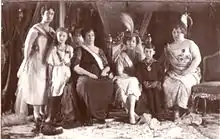خاندان عثمانی
خاندان عثمانی (ترکی عثمانی: خاندان آل عثمان) خاندان سلطنتی امپراتوری عثمانی بودند. بر طبق باورهای سنتی عثمانیها، اصالت آنان از قبیلهٔ کایی از ترکهای آغوز[1] بودند که تحت نظر عثمان یکم در سوگوت و بیلهجک در شمال غرب آناتولی زندگی میکردند. البته این نظر که آنان از قبیلهٔ قایی بودند توسط تاریخدانان مورد تردید واقع شدهاست.[2]
.svg.png.webp)
نماد عثمانیان

یک روز عروسی از خاندان عثمانی در سال ۱۹۲۰
پانویس
- Shaw, Stanford (1976). History of the Ottoman Empire and Modern Turkey. Cambridge University Press. p. 13.
- Kafadar, Cemal (1995). Between Two Worlds: The Construction of the Ottoman State. p. 122. ISBN 978-0-520-20600-7.
That they hailed from the Kayı branch of the Oğuz confederacy seems to be a creative "rediscovery" in the genealogical concoction of the fifteenth century. It is missing not only in Ahmedi but also, and more importantly, in the Yahşi Fakih-Aşıkpaşazade narrative, which gives its own version of an elaborate genealogical family tree going back to Noah. If there was a particularly significant claim to Kayı lineage, it is hard to imagine that Yahşi Fakih would not have heard of it
- Lowry, Heath (2003). The Nature of the Early Ottoman State. SUNY Press. p. 78. ISBN 0-7914-5636-6.
Based on these charters, all of which were drawn up between 1324 and 1360 (almost one hundred fifty years prior to the emergence of the Ottoman dynastic myth identifying them as members of the Kayı branch of the Oguz federation of Turkish tribes), we may posit that...
- Shaw, Stanford (1976). History of the Ottoman Empire and Modern Turkey. Cambridge University Press. p. 13.
The problem of Ottoman origins has preoccupied students of history, but because of both the absence of contemporary source materials and conflicting accounts written subsequent to the events there seems to be no basis for a definitive statement.
- Lowry, Heath (2003). The Nature of the Early Ottoman State. SUNY Press. p. 78. ISBN 0-7914-5636-6.
This article is issued from Wikipedia. The text is licensed under Creative Commons - Attribution - Sharealike. Additional terms may apply for the media files.